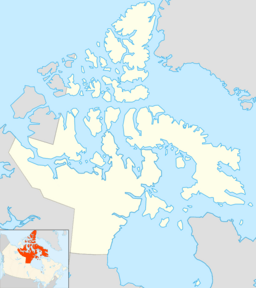Lady Franklin Bay facts for kids
Quick facts for kids Lady Franklin Bay |
|
|---|---|
| Location | Nares Strait |
| Coordinates | 81°40′N 65°00′W / 81.667°N 65.000°W |
| Basin countries | Canada |
| Max. length | 40 km (25 mi) |
| Max. width | 16 km (9.9 mi) |
| Settlements | Fort Conger (uninhabited) |
Lady Franklin Bay is a waterway located in the Arctic region of Canada. It's found in Nunavut, a large territory in northern Canada. This bay is an inlet on the northeastern coast of Ellesmere Island. It's a very cold and icy place!
Fort Conger, which used to be a camp for Arctic explorers, is located on the northern shore of the bay.
Contents
Exploring Lady Franklin Bay's Geography
Lady Franklin Bay helps separate two land areas: Grant Land to the north and Grinnell Land to the south.
How Big is Lady Franklin Bay?
The bay stretches inland for about 70 miles (110 km) from Hall Basin. It generally runs from the northeast to the southwest. The main part of the bay has a branch to the northwest called Discovery Bay. The inner parts of Lady Franklin Bay are sometimes called Archer Fjord on maps.
What is the Landscape Like?
The land around Lady Franklin Bay is mostly bare rock. There's also some very thin soil that is frozen solid. This frozen ground is called permafrost.
The bay is about 1,100 miles (1,800 km) north of the Arctic Circle. This means it gets sunlight for only about three months a year. Snowfall is light, and the bay's water is usually frozen all year round. Sometimes, the ice opens up, but it's still very hard to travel by ship. Even in summer, ice can make sea travel difficult up to 200 miles (320 km) south of the bay's entrance. However, the large glaciers on Ellesmere Island have not covered Lady Franklin Bay itself.
How to Reach the Bay
Ships can sometimes reach the main part of the bay if the ice allows. They would travel through Baffin Bay, then Smith Sound, to Kane Basin, through Kennedy Channel, and finally through Hall Basin. Historically, many Arctic trips started from St. John's in Canada.
Climate and Wildlife
The climate here is typical for the Arctic. It has very little rain or snow. Summers are short and cold, and winters are long, dark, and very cold.
During the short summer, you might see some animals. These include different mammals in the sea, like seals. Occasionally, muskox can be seen on land. Various seabirds fly overhead. Plants are rare and limited to mosses and lichens that grow during the short warm season.
History of Lady Franklin Bay
Lady Franklin Bay is named after Lady Franklin. She was the wife of a famous British explorer, Sir John Franklin. Sir John disappeared in 1845 while trying to find the Northwest Passage. This is a sea route through the Arctic. Lady Franklin became famous for funding many rescue missions to find her husband.
The Greely Expedition
Lady Franklin Bay became well-known in the United States between 1880 and 1884. The US Army Signal Corps chose this spot for a base camp. Their goal was to try and reach the North Pole.
In August 1881, a group of 25 military men arrived at Lady Franklin Bay. They were led by First Lieutenant Adolphus Greely. They built a large wooden building on the northwest shore. This home base camp was named Fort Conger.


